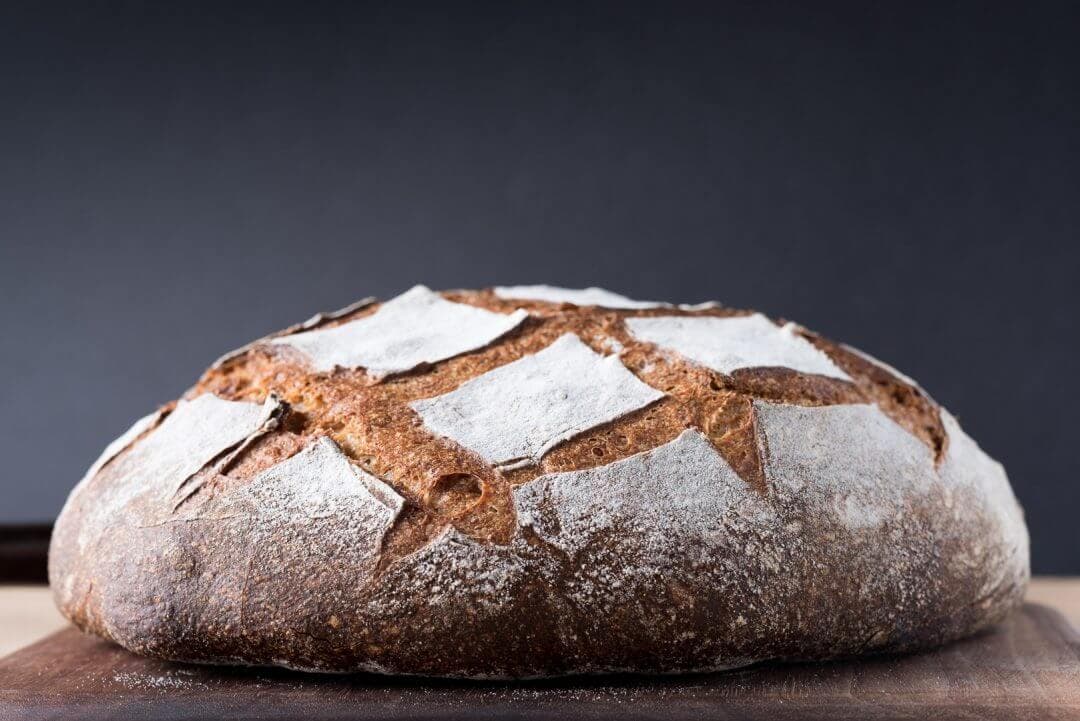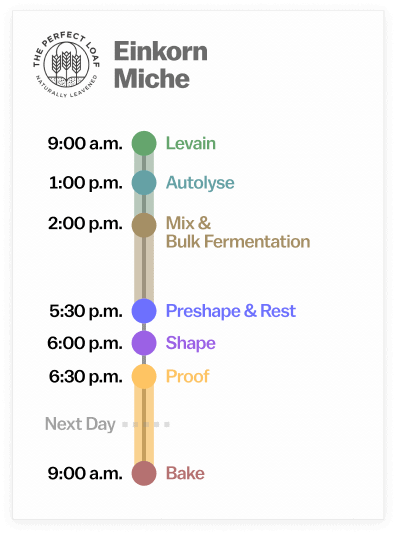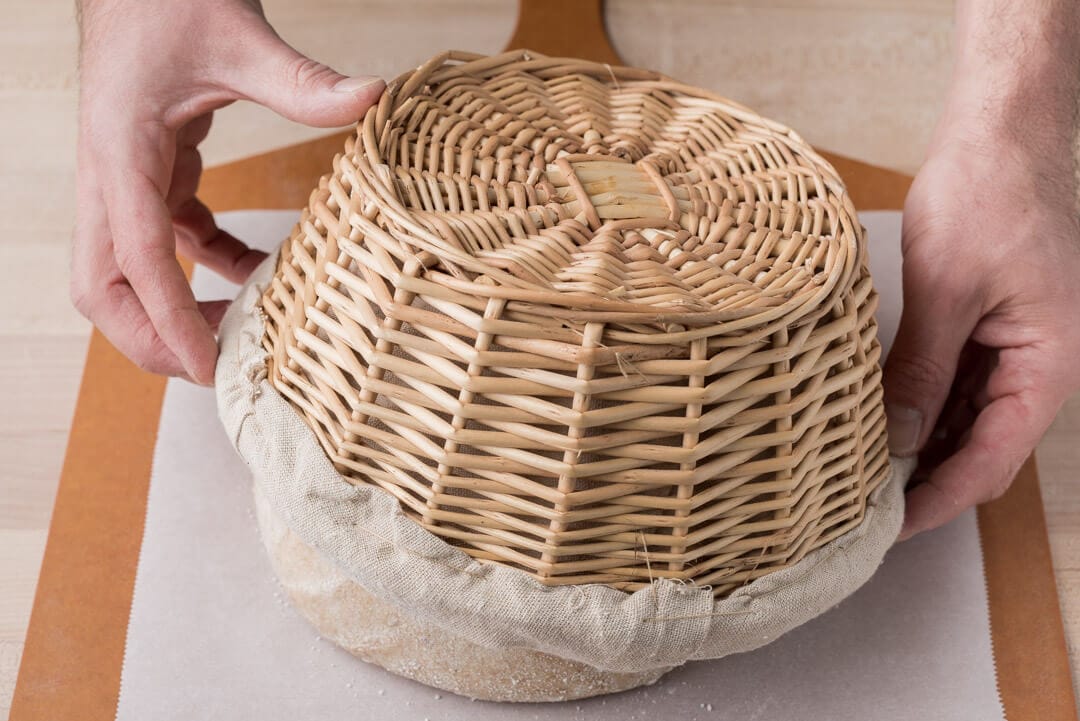This hefty einkorn miche bread recipe embodies community. Substantial in size, it is the ideal centerpiece for breaking bread with others, and its hearty flavor and nourishing quality will hearten all who gather at the dinner table. The loaf is so heavy it requires two hands to lift— oh, what a statement it makes.
Miche are large, round country-style loaves. Traditionally, they were meant to sustain a family for the days between their turn baking in the communal oven (and with natural leavening and all the subtle acidity built up through lengthy fermentation, they certainly will stay good for a long time3). If you think about it, a massive round loaf is probably the most efficient way to bake large quantities of dough: It takes up less space in the oven, has plenty of crust, can be divided and wrapped up, and if it’s meant to go to a single destination, a single loaf makes sense. A true daily bread.
Over time as the central community oven became increasingly scarce, these large loaves began to fall out of favor, and they were replaced by more ephemeral bread meant to be consumed entirely on a baking day. But there’s still a place for this beautiful and enticing loaf.
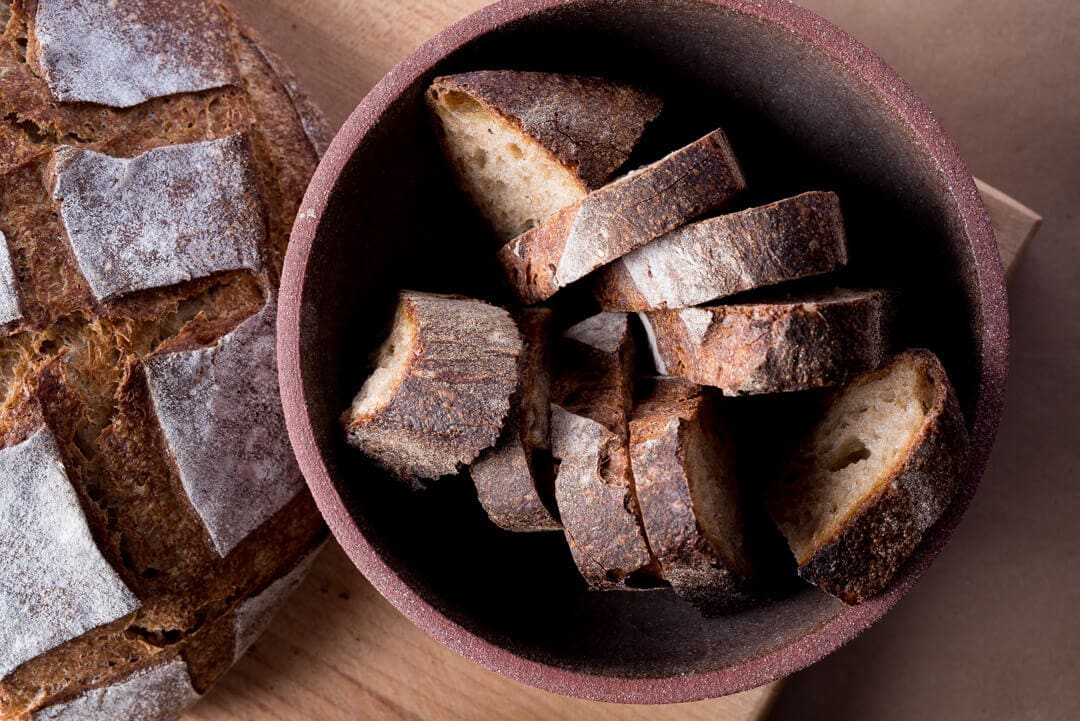
The high percentage of freshly milled einkorn and high extraction flour mean this is wholesome bread. Each bite feels good; it makes your body feel good; you know it’s healthy food. Real bread. I find the flavors in this loaf continue to develop and intensify one to two days after baking, and it’s the second day after baking when I find the flavor of einkorn at its paramount: nutty, sweet, and, dare I say, buttery.
The texture of the crust in this miche is phenomenal.
The texture of the crust in this miche is phenomenal. It’s crisp and substantial but not overly husky or overbearing; it’s the perfect match to the supple interior. It carries a wide range of colors, from light tans to dark hazel, and each slice has its character.
While the nature of this bread is rustic, it isn’t devoid of sophistication. The spacious round invites the baker to exercise creativity with scoring, as the loaf’s vast top surface is a perfect canvas for intricate designs or, as I show below, symmetrical patterns. With a beautiful score4 a miche never fails to rouse awe and even a surprised grin when you hand it over to the dinner host proclaiming, “Here’s just a little something for the table.”
Flour selection
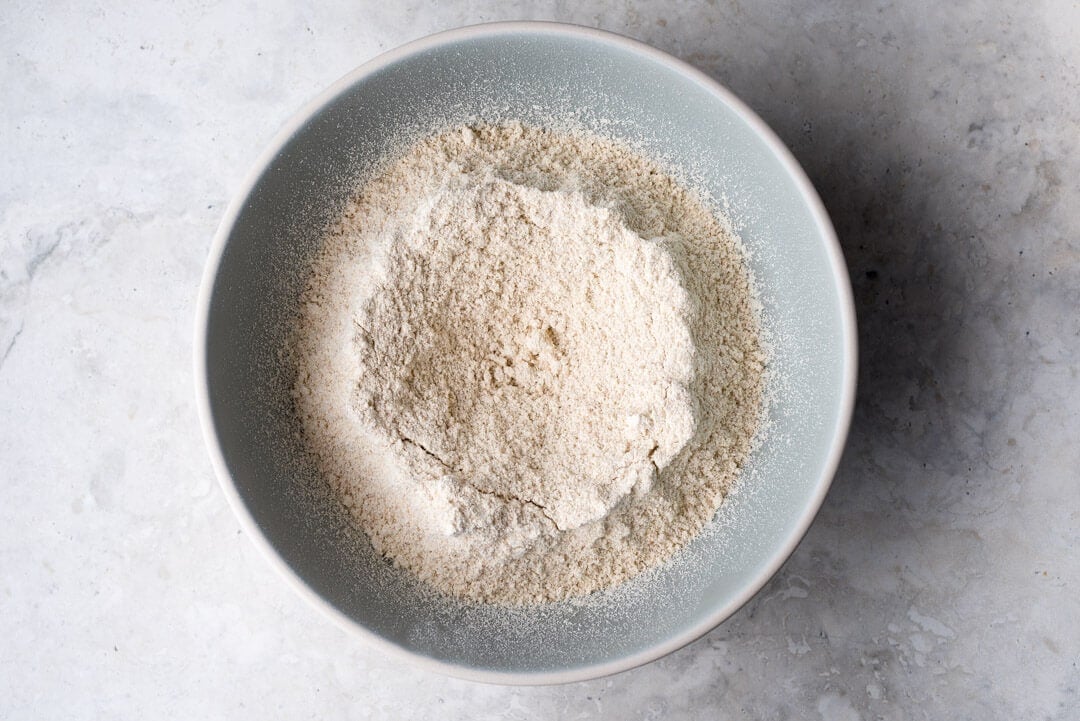
Einkorn grain and flour
I’ve been milling around (no pun intended) for far too long, trying to decide where first to use einkorn. I’ve read about its wonderful flavor, texture, and color. But I’ve also heard that it can be challenging at 100% extraction (whole grain) due to the nature of the grain’s protein: while the protein content is high for wheat (which is great, nutritionally), its delicate nature makes baking high-hydration hearth-style loaves more challenging. Therefore, in this recipe, I pair einkorn with a small percentage of high protein flour (“bread flour”) to achieve the balanced texture I’m after. But with a miche, we’re not looking for a dramatically open crumb or explosive oven spring; a miche is more about taste and texture—two things einkorn has in spades.
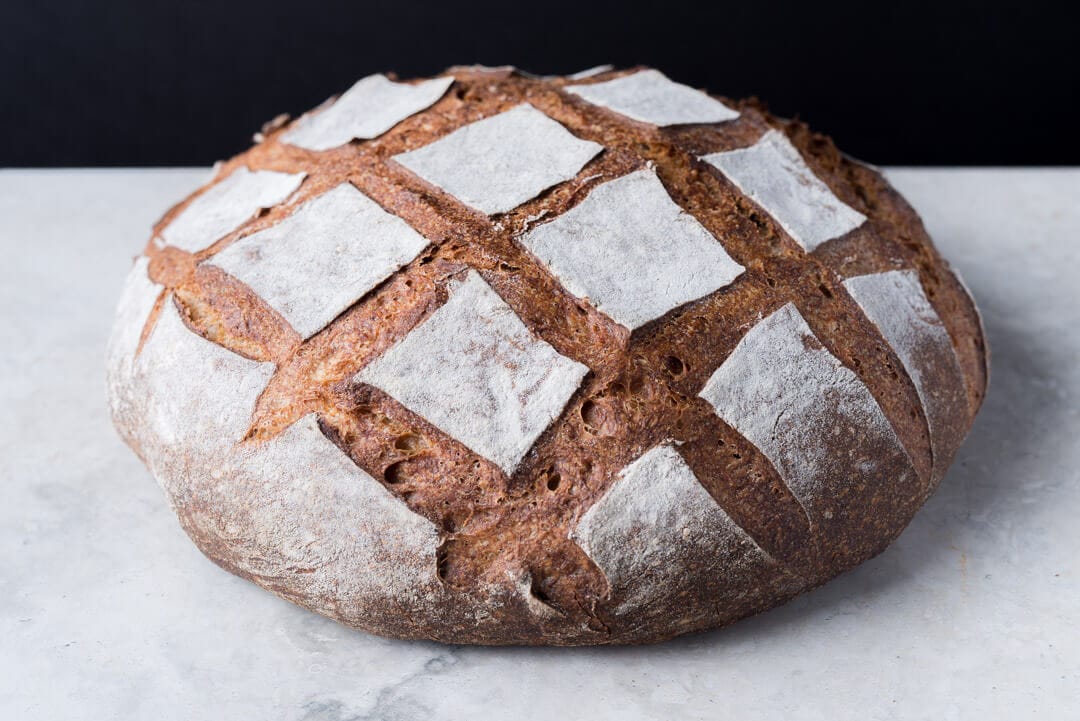
Right out of my grain mill, fresh einkorn flour has a silky feel and a buttery yellow complexion. The flour floats down in sheets and clumps readily when squeezed in hand—a good sign that the natural oils are preserved in the flour. It also has a remarkable aroma when the flour first touches water. All of these characteristics help produce a strikingly flavorful bread.
Jovial brand’s einkorn is entirely organic (and sourced from Italy!), and whole einkorn berries are available on their website. If you cannot mill your flour at home, Jovial sells whole grain einkorn flour, all-purpose flour, and even sprouted flour. (Many thanks to Jovial for sponsoring this post!) These options would be first-class substitutions for the freshly milled einkorn listed in my formula below, but know that choosing the all-purpose option will yield a milder flavored loaf, potentially with a more open interior too.
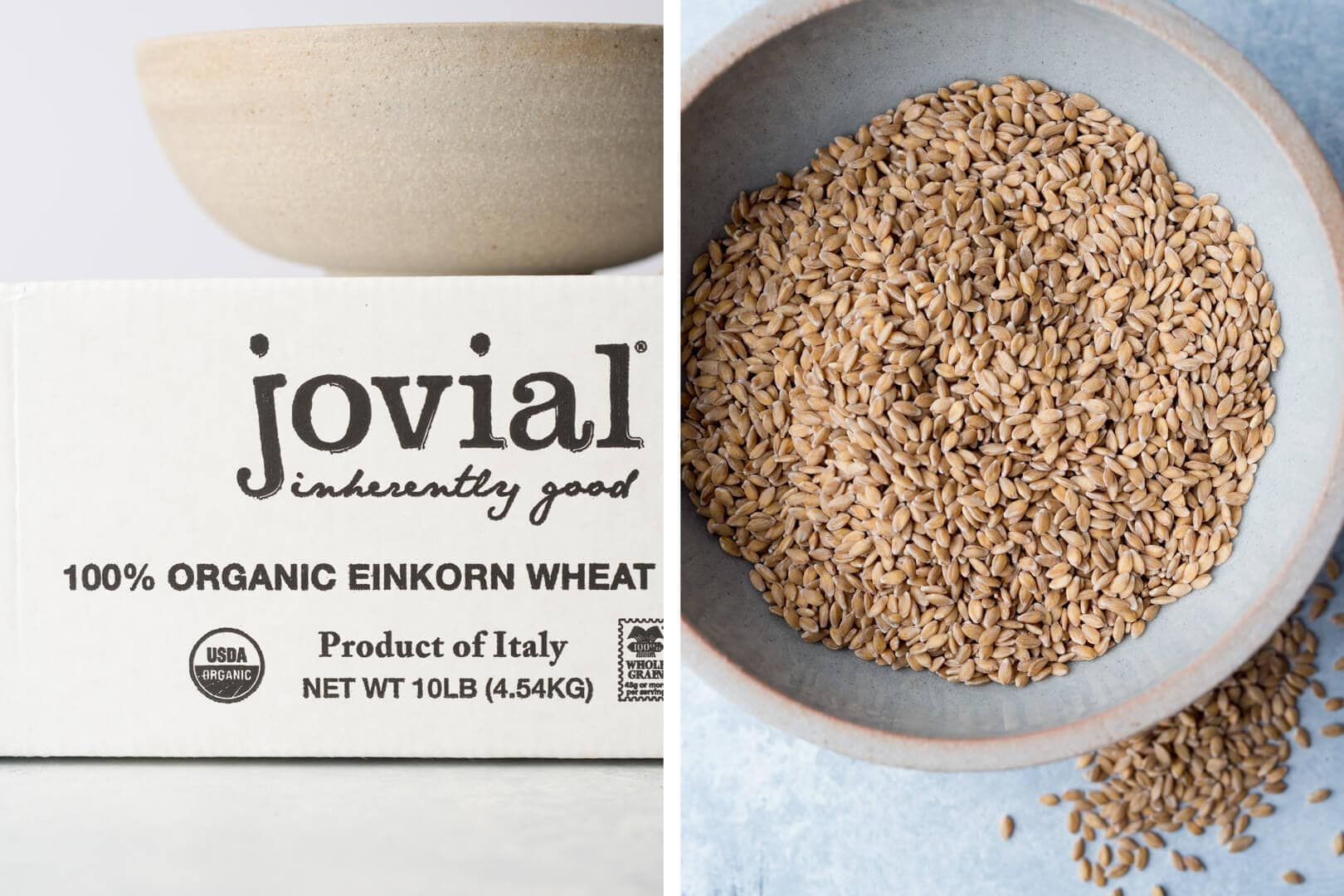
If you don’t have access to einkorn, I would experiment with freshly milled, or aged, whole red wheat in its place; the pronounced flavor of red wheat will add depth of flavor to the loaf. If you take this route, I would also add a small percentage of whole-grain rye flour (even just 5% will be noticeable) to round everything out.
Type 85 flour
I paired the einkorn flour with a high-extraction type 85 flour, which lands somewhere between whole wheat and white flour. The type 85 flour in the mix is appreciable and brings a nice wheaty backdrop, but it plays the second stage to the prominent einkorn flavor, which is the focus of this miche bread recipe.
If you don’t have high-extraction flour on hand, you can approximate this flour by blending about 70% white bread flour with 30% whole wheat flour. Another option is to bolt (sift) your own freshly milled flour.
Baking schedule
This miche bread recipe is made over two days, which gives the dough plenty of fermentation time for a deep and complex flavor.
It’s also possible to bake this loaf all in a single day by allowing the dough to proof on the counter, shaped and covered, until the dough is puffy, relaxed, and passes the dough poke test.
Einkorn miche bread recipe
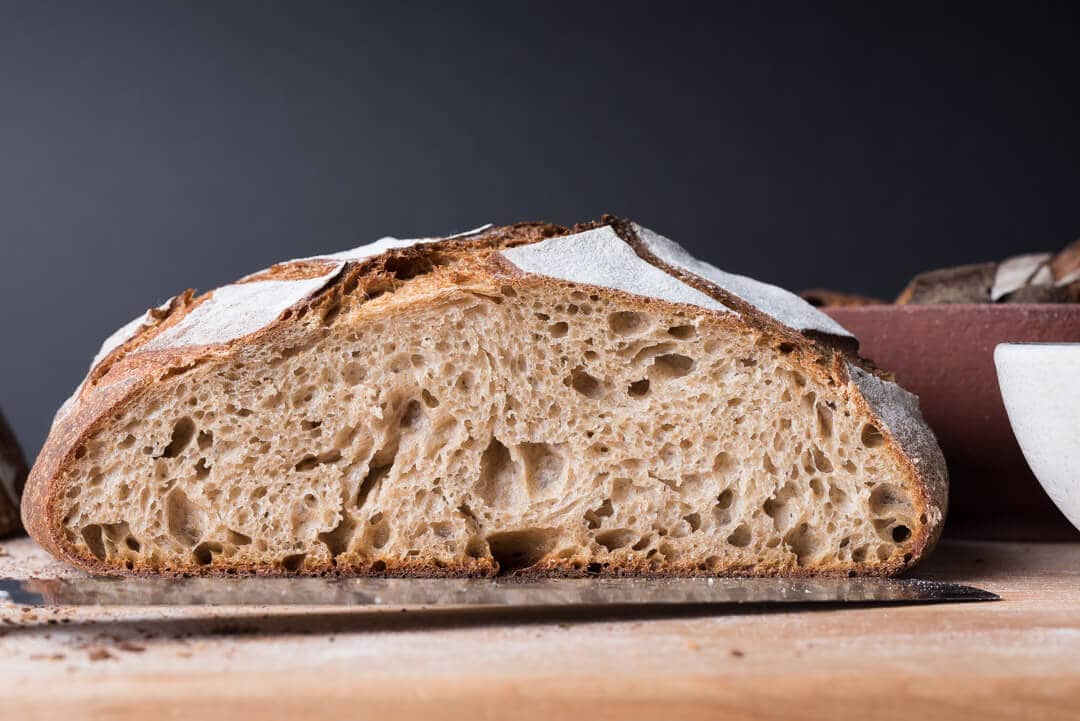
For tips on calculating baker’s percentages or modifying this formula, see my post on baker’s percentages (baker’s math).
Vitals
| Total dough weight | 1,500 grams |
| Pre-fermented flour | 7.5% |
| Levain in final dough | 16.2% |
| Hydration | 85.0% |
| Yield | One large miche |
Total formula
Desired dough temperature: 78°F (25°C) (see my post on the importance of dough temperature).
| Weight | Ingredient | Baker’s Percentage |
|---|---|---|
| 393g | Type 85 flour (Cairnspring Trailblazer Type 85) | 50.0% |
| 236g | Whole grain einkorn flour, freshly milled | 30.0% |
| 157g | High-protein bread flour (~12.7% protein, King Arthur Bread Flour) | 20.0% |
| 629g | Water 1 (levain and autolyse) | 80.0% |
| 39g | Water 2 (mix) | 5.0% |
| 1g | Diastatic malt powder (optional) | 0.1% |
| 16g | Fine sea salt | 2.0% |
| 29g | Ripe sourdough starter, 100% hydration | 3.8% |
Einkorn miche bread method
1. Prepare the levain – 9:00 a.m.
| Weight | Ingredient | Baker’s percentage |
| 59g | Type 85 flour | 100.0% |
| 29g | Water 1 (levain) | 50.0% |
| 29g | Ripe sourdough starter, 100% hydration | 50.0% |
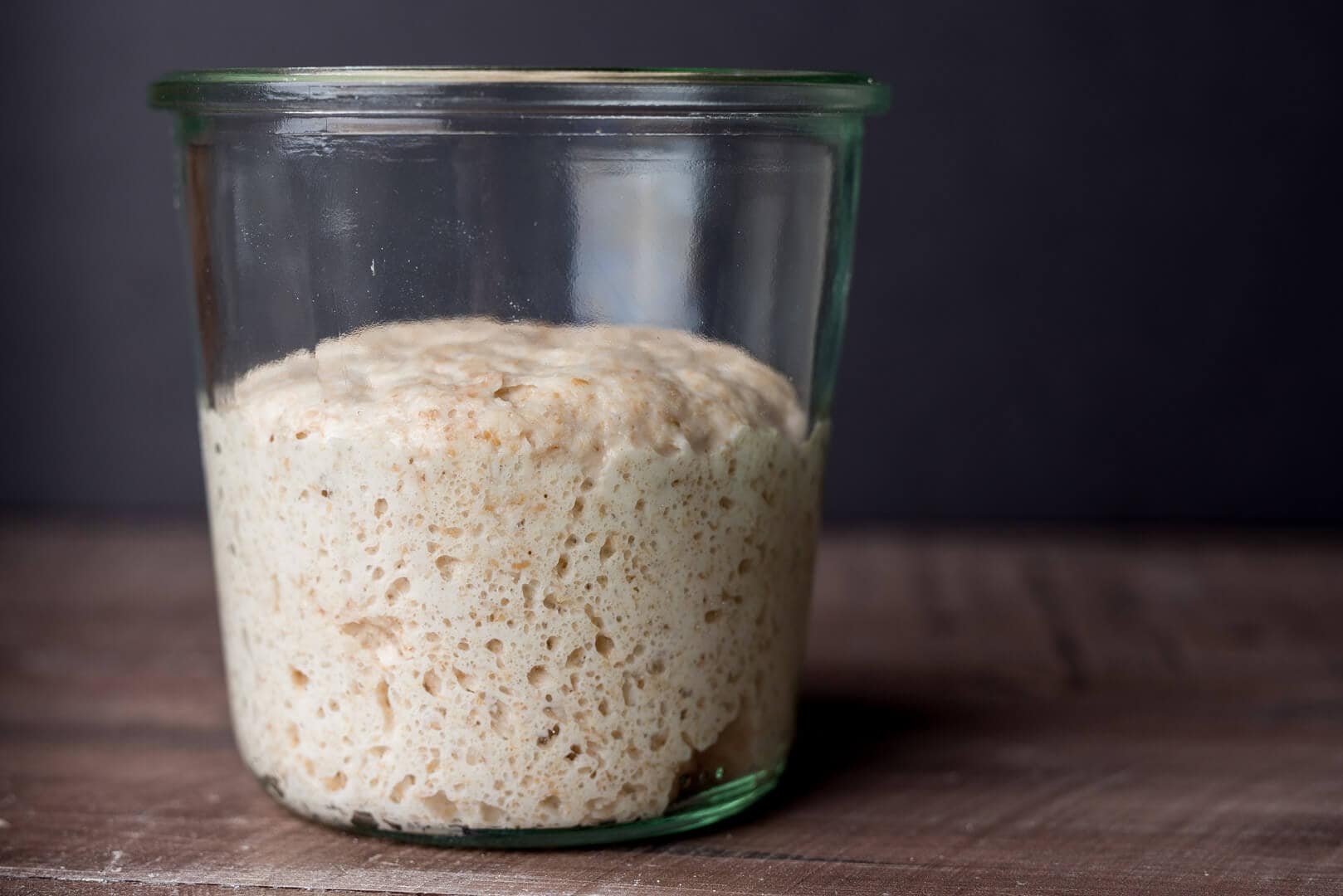
Mix the ingredients in the chart above in a jar and leave them covered at a warm temperature, 74-76°F (23-24°C), to ripen for 5 hours. This is a stiff levain, and if it is exceedingly hard to knead the ingredients together, use a little more water to make incorporation easier.
2. Autolyse – 1:00 p.m.
| Weight | Ingredient |
| 334g | Type 85 flour |
| 236g | Whole grain einkorn flour |
| 157g | High-protein bread flour |
| 599g | Water 1 (autolyse) |
| 1g | Diastatic malt powder |
I use the autolyse technique for this miche bread recipe to help reduce the total mixing time required.
Warm or cool the autolyse water so that the temperature of the mixed dough meets the FDT (final dough temperature) of 78°F (25°C) for this recipe. Place the flour, optional malt powder, and water 1 in a large bowl. Use wet hands to mix until no dry bits remain; the dough will be shaggy and loose. Use a bowl scraper to scrape down the sides of the bowl to keep all the dough in one area at the bottom. Cover the bowl and place it near your levain for 1 hour.
3. Mix – 2:00 p.m.
| Weight | Ingredient |
| 94g | Water 2 (mix) |
| 17g | Fine sea salt |
| 117g | Ripe levain (from Step 1) |
Add the salt and levain to the top of the dough in autolyse and use a splash of water 2 to moisten. With wet hands, mix thoroughly. Add the remaining water if the dough feels like it can handle it. Next, knead the dough for a few minutes using either the slap and fold technique or folds in the bowl. For this dough, I kneaded for about 5 minutes until the dough smoothed and became elastic.
Transfer the dough to a bulk fermentation container and cover.
4. Bulk fermentation – 2:30 a.m. to 5:30 p.m. (3 hours)
At a warm room temperature, 74-76°F (23-24°C), bulk fermentation should take about 3 hours.
This dough will require 3 sets of stretches and folds during bulk fermentation. After the first 30 minutes, wet your hands, grab the side of the dough farthest from you, and stretch it over to the other side. Rotate the bowl 180 degrees and repeat. Then rotate the bowl a quarter turn and stretch and fold that side. Rotate the bowl 180 degrees again and finish with a stretch and fold on the last side. The dough should be neatly folded up in the bowl. Cover and repeat these folds every 30 minutes for a total of 3 sets of stretches and folds. Then let the dough rest, covered, for the remainder of bulk fermentation.
5. Preshape – 5:30 p.m.
After 3 hours, the dough should be well-risen in the bulk fermentation container and puffy to the touch. The edge where the dough meets the container should be domed downward, showing strength and rise.
Fill a small bowl with water and place it next to your work surface. Scrape the dough onto a clean counter. With your free hand wet and bench knife in the other, preshape the single piece of dough into a loose round.
Let the dough rest, uncovered, for 30 minutes.
6. Shape – 6:00 p.m.
Flour the top of the preshaped round and your work surface. Using your bench knife, flip the round over onto the floured area. Using floured hands, shape the dough into a boule (round). Gently transfer the dough to a proofing basket at least 8 inches in diameter, seam-side up.
The 8-inch round baskets I’m using for this recipe can be found at SFBI.
7. Proof – 6:30 p.m. to 9:00 a.m.
Cover the basket with a large, reusable plastic bag and seal shut. Place the basket in the refrigerator to proof overnight.
8. Bake – 9:00 a.m.
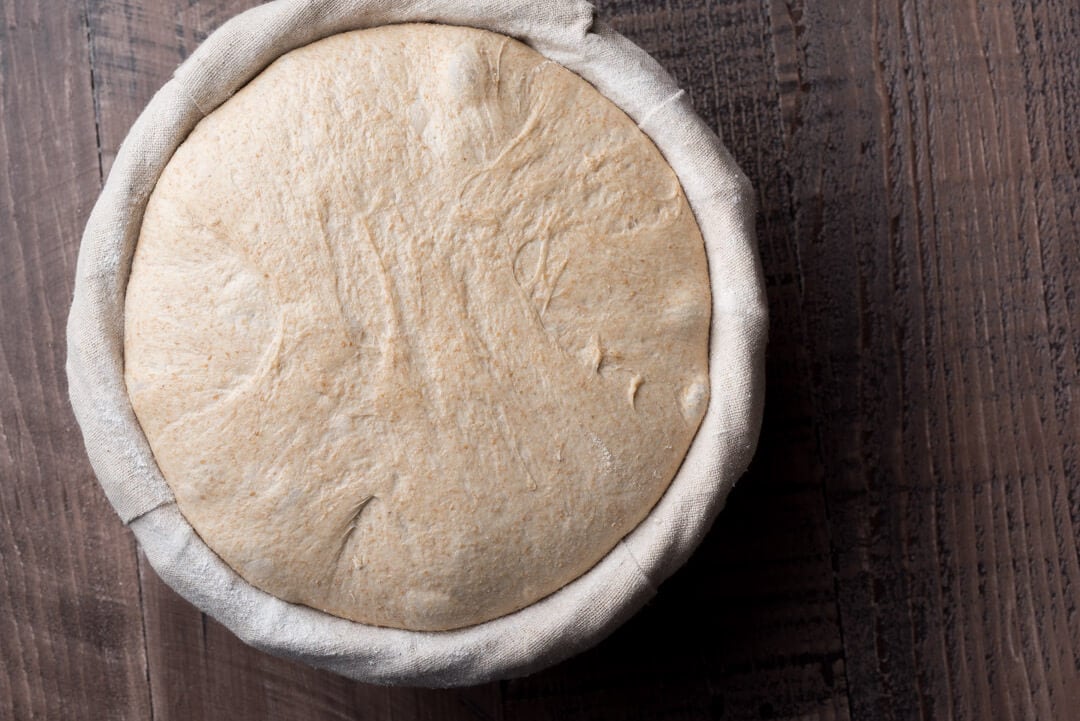
Place an oven rack in the bottom-third of the oven and preheat it to 450°F (230°C). Due to the large size of this loaf, a typical Dutch oven or Combo cooker may have trouble fitting the dough. I prefer to bake this miche directly on a baking surface and steam my oven. See my guide to steaming a home oven for bread baking for instructions.
Take the proofing basket out of the fridge, uncover it, and put a piece of parchment paper over the basket. Place a pizza peel or inverted baking sheet on top of the parchment and, using both hands, flip everything over. Gently remove the basket and score the dough.
I like to score this miche bread recipe dough with a cross-hatch design on top, but any scoring pattern for a boule will work well. See some more bread scoring ideas in my video, below:
Slide the dough into the oven. Steam the oven by pouring ice into the preheated pan at the bottom of the oven. Bake for 30 minutes. Vent the oven of steam by removing the steaming pans. Continue to bake for 35 minutes more. When done, the loaf should have an internal temperature of around 204°F (95°C), and the crust should be deeply colored. Let the loaf cool on a wire rack for at least 3 to 4 hours before slicing.
The final baked miche bread recipe will keep well for at least a week if the bread is stored properly.
Print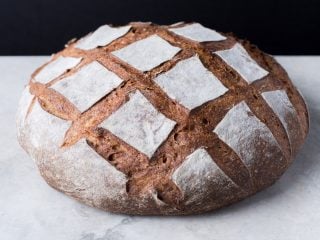
Einkorn Miche Bread Recipe
- Author: Maurizio Leo
- Prep Time: 25 hours
- Cook Time: 1 hour, 5 minutes
- Total Time: 26 hours 5 minutes
- Yield: 1 loaf
- Category: Dinner, Main course
- Method: Baked
- Cuisine: French
Description
A large loaf with a complex and lingering flavor. This miche is perfect for large gatherings or as a single bread to sustain a family for an entire week.
Ingredients
Levain
- 59g Type 85 flour
- 29g Water
- 29g Ripe sourdough starter, 100% hydration
Autolyse
- 334g Type 85 flour
- 236g Whole grain einkorn flour, freshly milled
- 157g High-protein bread flour
- 599g water
- 1g diastatic malt powder
Main dough
- 94g Water
- 17g Fine sea salt
- 117g Ripe levain
Instructions
- Levain (9:00 a.m.)
In a small bowl or jar, mix the Levain ingredients. Cover the jar and keep it at a warm temperature for 5 hours. - Autolyse (1:00 p.m)
In a mixing bowl, add the autolyse ingredients until no dry bits remain. Cover the bowl and let rest for 1-hour. - Mix (2:00 p.m.)
Add the about half the water 2, salt, and levain to the top of the dough that was just in autolyse. With wet hands, mix thoroughly. Next, knead the dough for a few minutes (I used the slap and fold technique) until elastic and slightly smooth. If it feels like the dough can handle it, add the remaining water 2. Mix by pinching and folding until the ingredients are thoroughly incorporated and the dough is cohesive. Transfer the dough back to the bowl or to a container for bulk fermentation and cover. - Bulk Fermentation (2:30 p.m. to 5:30 p.m.)
This dough will require 3 sets of stretches and folds during bulk fermentation. After the first 30 minutes, wet your hands, grab the side of the dough farthest from you, and stretch it over to the other side. Rotate the bowl 180 degrees and repeat. Then rotate the bowl a quarter turn and stretch and fold that side. Rotate the bowl 180 degrees again and finish with a stretch and fold on the last side. The dough should be neatly folded up in the bowl. Cover and repeat these folds every 30 minutes for a total of 3 sets of stretches and folds. Then let the dough rest, covered, for the remainder of bulk fermentation. - Preshape (5:30 p.m.)
Fill a small bowl with water and place it next to your work surface. Scrape the dough onto a clean counter. With your free hand wet and bench knife in the other, preshape the single piece of dough into a loose round. - Shape (6:00 p.m.)
Lightly flour the top of your preshaped round and using floured hands, shape the dough into an round (boule) shape, then place the dough in its proofing basket, seam side up. - Proof (6:30 p.m. to 9:00 a.m. the next day)
Cover the proofing basket with reusable plastic and seal. Then, place it into the refrigerator and proof overnight. - Bake (The next day, 9:00 a.m.)
Place an oven rack in the bottom-third of the oven and preheat it to 450°F (230°C). I bake this miche directly on a baking surface and steam my oven. See my guide to steaming a home oven for bread baking for instructions. Take the proofing basket out of the fridge, uncover it, and put a piece of parchment paper over the basket. Place a pizza peel or inverted baking sheet on top of the parchment and, using both hands, flip everything over. Gently remove the basket and score the dough. Slide the dough into the oven. Steam the oven by pouring ice into the preheated pan at the bottom of the oven. Bake for 30 minutes. Vent the oven of steam by removing the steaming pans. Continue to bake for 35 minutes more. When done, the loaf should have an internal temperature of around 204°F (95°C), and the crust should be deeply colored. Let the loaf cool on a wire rack for 3 to 4 hours before slicing.
Notes
If you don’t have diastatic malt powder, it can be omitted.
If you don’t have type 85 flour, substitute it out for a mix of 70% bread flour and 30% whole wheat flour.
What’s next?
While a large, deeply flavorful miche is a really wonderful thing, the other side of the spectrum can be delightful, too. Check out my recipe for sourdough baguettes: ultra-crunchy, very mildly flavored, and light in hand—perfect for a delicate sandwich or simply sliced and topped with butter.
If you use this recipe, tag @maurizio on Instagram so I can take a look!
As you know, sourdough breads keep incredible well due to the natural acids produced as a byproduct of lengthy fermentation.↩
Or to be completely honest, even without a beautiful score.↩
As you know, sourdough breads keep incredible well due to the natural acids produced as a byproduct of lengthy fermentation.↩
Or to be completely honest, even without a beautiful score.↩


